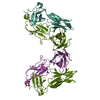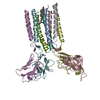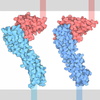[English] 日本語
 Yorodumi
Yorodumi- PDB-8wyi: T cell receptor delta 2 gamma 9 with TCRD TM domain chimera of TRAC -
+ Open data
Open data
- Basic information
Basic information
| Entry | Database: PDB / ID: 8wyi | ||||||
|---|---|---|---|---|---|---|---|
| Title | T cell receptor delta 2 gamma 9 with TCRD TM domain chimera of TRAC | ||||||
 Components Components |
| ||||||
 Keywords Keywords | IMMUNE SYSTEM / immune / receptor | ||||||
| Function / homology |  Function and homology information Function and homology informationMHC protein binding / regulation of lymphocyte apoptotic process / gamma-delta T cell receptor complex / Fc-gamma receptor III complex / T cell anergy / positive regulation of T cell anergy / positive regulation of cell-cell adhesion mediated by integrin / gamma-delta T cell activation / CD4-positive, alpha-beta T cell proliferation / negative thymic T cell selection ...MHC protein binding / regulation of lymphocyte apoptotic process / gamma-delta T cell receptor complex / Fc-gamma receptor III complex / T cell anergy / positive regulation of T cell anergy / positive regulation of cell-cell adhesion mediated by integrin / gamma-delta T cell activation / CD4-positive, alpha-beta T cell proliferation / negative thymic T cell selection / Fc-gamma receptor signaling pathway / positive regulation of CD4-positive, alpha-beta T cell proliferation / alpha-beta T cell receptor complex / positive regulation of protein localization to cell surface / positive thymic T cell selection / Nef and signal transduction / signal complex assembly / positive regulation of cell-matrix adhesion / T cell receptor complex / smoothened signaling pathway / establishment or maintenance of cell polarity / small molecule binding / positive regulation of interleukin-4 production / Translocation of ZAP-70 to Immunological synapse / Phosphorylation of CD3 and TCR zeta chains / dendrite development / protein complex oligomerization / alpha-beta T cell activation / FCGR activation / Generation of second messenger molecules / immunological synapse / PD-1 signaling / Role of phospholipids in phagocytosis / T cell receptor binding / cell surface receptor protein tyrosine kinase signaling pathway / positive regulation of T cell proliferation / negative regulation of smoothened signaling pathway / T cell costimulation / positive regulation of interleukin-2 production / positive regulation of calcium-mediated signaling / protein tyrosine kinase binding / FCGR3A-mediated IL10 synthesis / cerebellum development / T cell activation / apoptotic signaling pathway / FCGR3A-mediated phagocytosis / response to bacterium / calcium-mediated signaling / clathrin-coated endocytic vesicle membrane / Regulation of actin dynamics for phagocytic cup formation / SH3 domain binding / positive regulation of type II interferon production / peptide antigen binding / positive regulation of peptidyl-tyrosine phosphorylation / Immunoregulatory interactions between a Lymphoid and a non-Lymphoid cell / transmembrane signaling receptor activity / cell-cell junction / protein transport / Cargo recognition for clathrin-mediated endocytosis / Downstream TCR signaling / signaling receptor complex adaptor activity / Clathrin-mediated endocytosis / T cell receptor signaling pathway / cell body / protein-containing complex assembly / regulation of apoptotic process / adaptive immune response / dendritic spine / cell surface receptor signaling pathway / protein heterodimerization activity / G protein-coupled receptor signaling pathway / external side of plasma membrane / negative regulation of gene expression / innate immune response / positive regulation of gene expression / protein kinase binding / Golgi apparatus / endoplasmic reticulum / protein homodimerization activity / identical protein binding / plasma membrane / cytosol / cytoplasm Similarity search - Function | ||||||
| Biological species |  Homo sapiens (human) Homo sapiens (human) | ||||||
| Method | ELECTRON MICROSCOPY / single particle reconstruction / cryo EM / Resolution: 3.9 Å | ||||||
 Authors Authors | Xin, W. / Huang, B. / Chi, X. / Liu, Y. / Xu, M. / Zhang, Y. / Li, X. / Su, Q. / Zhou, Q. | ||||||
| Funding support |  China, 1items China, 1items
| ||||||
 Citation Citation |  Journal: Nature / Year: 2024 Journal: Nature / Year: 2024Title: Structures of human γδ T cell receptor-CD3 complex. Authors: Weizhi Xin / Bangdong Huang / Ximin Chi / Yuehua Liu / Mengjiao Xu / Yuanyuan Zhang / Xu Li / Qiang Su / Qiang Zhou /  Abstract: Gamma delta (γδ) T cells, a unique T cell subgroup, are crucial in various immune responses and immunopathology. The γδ T cell receptor (TCR), which is generated by γδ T cells, recognizes a ...Gamma delta (γδ) T cells, a unique T cell subgroup, are crucial in various immune responses and immunopathology. The γδ T cell receptor (TCR), which is generated by γδ T cells, recognizes a diverse range of antigens independently of the major histocompatibility complex. The γδ TCR associates with CD3 subunits, initiating T cell activation and holding great potential in immunotherapy. Here we report the structures of two prototypical human Vγ9Vδ2 and Vγ5Vδ1 TCR-CD3 complexes, revealing two distinct assembly mechanisms that depend on Vγ usage. The Vγ9Vδ2 TCR-CD3 complex is monomeric, with considerable conformational flexibility in the TCRγ-TCRδ extracellular domain and connecting peptides. The length of the connecting peptides regulates the ligand association and T cell activation. A cholesterol-like molecule wedges into the transmembrane region, exerting an inhibitory role in TCR signalling. The Vγ5Vδ1 TCR-CD3 complex displays a dimeric architecture, whereby two protomers nestle back to back through the Vγ5 domains of the TCR extracellular domains. Our biochemical and biophysical assays further corroborate the dimeric structure. Importantly, the dimeric form of the Vγ5Vδ1 TCR is essential for T cell activation. These findings reveal organizing principles of the γδ TCR-CD3 complex, providing insights into the unique properties of γδ TCR and facilitating immunotherapeutic interventions. | ||||||
| History |
|
- Structure visualization
Structure visualization
| Structure viewer | Molecule:  Molmil Molmil Jmol/JSmol Jmol/JSmol |
|---|
- Downloads & links
Downloads & links
- Download
Download
| PDBx/mmCIF format |  8wyi.cif.gz 8wyi.cif.gz | 150.1 KB | Display |  PDBx/mmCIF format PDBx/mmCIF format |
|---|---|---|---|---|
| PDB format |  pdb8wyi.ent.gz pdb8wyi.ent.gz | 104.8 KB | Display |  PDB format PDB format |
| PDBx/mmJSON format |  8wyi.json.gz 8wyi.json.gz | Tree view |  PDBx/mmJSON format PDBx/mmJSON format | |
| Others |  Other downloads Other downloads |
-Validation report
| Summary document |  8wyi_validation.pdf.gz 8wyi_validation.pdf.gz | 417.8 KB | Display |  wwPDB validaton report wwPDB validaton report |
|---|---|---|---|---|
| Full document |  8wyi_full_validation.pdf.gz 8wyi_full_validation.pdf.gz | 419.8 KB | Display | |
| Data in XML |  8wyi_validation.xml.gz 8wyi_validation.xml.gz | 11.5 KB | Display | |
| Data in CIF |  8wyi_validation.cif.gz 8wyi_validation.cif.gz | 17.8 KB | Display | |
| Arichive directory |  https://data.pdbj.org/pub/pdb/validation_reports/wy/8wyi https://data.pdbj.org/pub/pdb/validation_reports/wy/8wyi ftp://data.pdbj.org/pub/pdb/validation_reports/wy/8wyi ftp://data.pdbj.org/pub/pdb/validation_reports/wy/8wyi | HTTPS FTP |
-Related structure data
| Related structure data |  37929MC  8jbvC  8jc0C  8jcbC  8wxeC  8wy0C  8yc0C M: map data used to model this data C: citing same article ( |
|---|---|
| Similar structure data | Similarity search - Function & homology  F&H Search F&H Search |
- Links
Links
- Assembly
Assembly
| Deposited unit | 
|
|---|---|
| 1 |
|
- Components
Components
-T-cell surface glycoprotein CD3 ... , 4 types, 6 molecules abdefg
| #1: Protein | Mass: 21809.695 Da / Num. of mol.: 2 Source method: isolated from a genetically manipulated source Details: 168-195: twin-Strep tag / Source: (gene. exp.)  Homo sapiens (human) / Gene: CD247, CD3Z, T3Z, TCRZ / Production host: Homo sapiens (human) / Gene: CD247, CD3Z, T3Z, TCRZ / Production host:  Homo sapiens (human) / References: UniProt: P20963 Homo sapiens (human) / References: UniProt: P20963#2: Protein | | Mass: 18949.537 Da / Num. of mol.: 1 Source method: isolated from a genetically manipulated source Source: (gene. exp.)  Homo sapiens (human) / Gene: CD3D, T3D / Production host: Homo sapiens (human) / Gene: CD3D, T3D / Production host:  Homo sapiens (human) / References: UniProt: P04234 Homo sapiens (human) / References: UniProt: P04234#3: Protein | Mass: 23174.227 Da / Num. of mol.: 2 Source method: isolated from a genetically manipulated source Source: (gene. exp.)  Homo sapiens (human) / Gene: CD3E, T3E / Production host: Homo sapiens (human) / Gene: CD3E, T3E / Production host:  Homo sapiens (human) / References: UniProt: P07766 Homo sapiens (human) / References: UniProt: P07766#4: Protein | | Mass: 20493.457 Da / Num. of mol.: 1 Source method: isolated from a genetically manipulated source Source: (gene. exp.)  Homo sapiens (human) / Gene: CD3G, T3G / Production host: Homo sapiens (human) / Gene: CD3G, T3G / Production host:  Homo sapiens (human) / References: UniProt: P09693 Homo sapiens (human) / References: UniProt: P09693 |
|---|
-Signal peptide,flag tag,T cell receptor ... , 2 types, 2 molecules mn
| #5: Protein | Mass: 34560.738 Da / Num. of mol.: 1 Source method: isolated from a genetically manipulated source Details: TCRDV2 with TM domain change to TRAC TM domain. / Source: (gene. exp.)  Homo sapiens (human) / Gene: TRDV2, hDV102S1, TRDC, TRAC, TCRA / Production host: Homo sapiens (human) / Gene: TRDV2, hDV102S1, TRDC, TRAC, TCRA / Production host:  Homo sapiens (human) Homo sapiens (human)References: UniProt: A0JD36, UniProt: B7Z8K6, UniProt: P01848 |
|---|---|
| #6: Protein | Mass: 37406.973 Da / Num. of mol.: 1 Source method: isolated from a genetically manipulated source Source: (gene. exp.)  Homo sapiens (human) / Gene: TRGV9, TCRGV9, TRGC1, TCRGC1 / Production host: Homo sapiens (human) / Gene: TRGV9, TCRGV9, TRGC1, TCRGC1 / Production host:  Homo sapiens (human) / References: UniProt: Q99603, UniProt: P0CF51 Homo sapiens (human) / References: UniProt: Q99603, UniProt: P0CF51 |
-Experimental details
-Experiment
| Experiment | Method: ELECTRON MICROSCOPY |
|---|---|
| EM experiment | Aggregation state: PARTICLE / 3D reconstruction method: single particle reconstruction |
- Sample preparation
Sample preparation
| Component | Name: T cell receptor delta 2 gamma 9 with TCRD TM domain change to TRAC TM domain Type: COMPLEX / Entity ID: all / Source: RECOMBINANT |
|---|---|
| Source (natural) | Organism:  Homo sapiens (human) Homo sapiens (human) |
| Source (recombinant) | Organism:  Homo sapiens (human) Homo sapiens (human) |
| Buffer solution | pH: 7.4 |
| Specimen | Embedding applied: NO / Shadowing applied: NO / Staining applied: NO / Vitrification applied: YES |
| Vitrification | Cryogen name: ETHANE |
- Electron microscopy imaging
Electron microscopy imaging
| Experimental equipment |  Model: Titan Krios / Image courtesy: FEI Company |
|---|---|
| Microscopy | Model: FEI TITAN KRIOS |
| Electron gun | Electron source:  FIELD EMISSION GUN / Accelerating voltage: 300 kV / Illumination mode: SPOT SCAN FIELD EMISSION GUN / Accelerating voltage: 300 kV / Illumination mode: SPOT SCAN |
| Electron lens | Mode: BRIGHT FIELD / Nominal defocus max: 2000 nm / Nominal defocus min: 1000 nm |
| Image recording | Electron dose: 50 e/Å2 / Film or detector model: GATAN K3 BIOQUANTUM (6k x 4k) |
- Processing
Processing
| CTF correction | Type: PHASE FLIPPING AND AMPLITUDE CORRECTION |
|---|---|
| 3D reconstruction | Resolution: 3.9 Å / Resolution method: FSC 0.143 CUT-OFF / Num. of particles: 275838 / Symmetry type: POINT |
 Movie
Movie Controller
Controller

















 PDBj
PDBj















